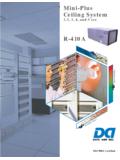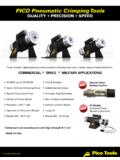Transcription of M4™ SAMPLING VALVE - Keofitt
1 DON T GAMBLE WITH YOUR SAMPLE M4 SAMPLING VALVEUser ManUalDOCUMENT VERSION LOGThe table below lists previous versions of this User Manual and states the major changes between version list is introduced in November #Version dateMajor changes from previous versions1 September 2015 Latest version without version log 211th November 2015 Various amendments to the text in 5, , , Major change in Viscosity range in new chapter Flow. Added Warning in New chapter about lubricating turn knob. New illustration in 14. INTRODUCTION: MANUFACTURER: Keofitt A/S Kullinggade 31 5700 Svendborg, Denmark TYPE: M4 SAMPLING VALVE PATENTS: PAT. 5,246,204 0468957 YEAR OF INTRODUCTION: 1998 YEAR OF REVISED DESIGN: 2014 LAST UPDATED: Dec.
2 2017 The English version of this Manual is the governing version and it is the only authorized version. Consequently, Keofitt cannot be held liable for other versions including translations of this PRESENTATION .. Definition of terms .. Quick start ..92. CLEANING DISINFECTION STERILISATION .. Clean-In-Place (CIP) .. Sterilisation ..113. VALVE FUNCTION ..124. EVERYDAY USE OF THE VALVE .. Pre-production treatment .. Chemical cleaning, CIP .. Chemical Disinfection .. Steam sterilisation ..145. VALVE OPERATIONS .. Chemical CIP .. Chemical disinfection .. Steam sterilisation .. SAMPLING ..206. TECHNICAL DATA .. Material .. Certificate .. Pressure (max.) .. Temperature (max.) .. Surface finish .. Viscosity: .. Flow ..227. VALVE BODIES ..238. VALVE HEADS ..249.
3 PARTS & ACCESSORIES .. INSTRUCTIONS .. Location .. Before welding ..2611. WELDING Welding method .. Guideline welding values ..2712. BLOCK Keofitt VALVE type T (tank) .. Keofitt VALVE type P (pipe).. Keofitt VALVE type P (pipe connection vertical) Inline .. Keofitt VALVE type clamp connection .. Keofitt VALVE type Varivent .. Keofitt VALVE type thread ..3013. MAINTENANCE .. Spare parts list .. Disassembly and assembly of VALVE body and head .. Disassembly of VALVE head ..3214. INSTRUCTIONS ON REPLACING PTFE MEMBRANE ..3315. UPGRADE FROM SILICONE/EPDM TO PTFE MEMBRANE .. For manually operated VALVE heads type H, K and Q .. For manually operated VALVE heads type B .. For pneumatically operated VALVE heads type N ..3516. MEMBRANES .. Silicone membrane - art. no. 400051 .. EPDM membrane - art.
4 No. 400052 .. PTFE membrane - art. no. 400055 ..39 Keofitt USER MANUAL PAGE 71. PRESENTATIONThe Keofitt M4 SAMPLING VALVE can be readily cleaned and disinfected/sterilised as it meets both hygienic and process design requirements. Effective cleaning and disinfection/sterilisation of the SAMPLING VALVE can be carried out between random samples independently of the course of the production process without compromising the same. The coaxial design and the electro polished VALVE interior ensure absolute M4 VALVE is 3-A authorised and EHEDG Type EL Class I certified. The American 3-A Sanitary Standard is normative for the component s ease of cleaning and sterilisation and ensures optimum conditions for food products, which comes in contact with the component in question. The European EHEDG Type EL certificate is issued based on the cleanability of the VALVE and the test method is an indicator of good inherent hygienic equipment valves are used in a wide range of processing industries, such as breweries, dairies, juice/soft drinks and the biotechnological and pharmaceutical Definition of termsIn order to ease the reading of this manual and to avoid any misunderstanding, please refer to the definition of terms in the table below.
5 TERMDEFINITION3-A Sanitary Standard3-A SSI is an independent, not-for-profit US corporation dedicated to advancing hygienic equipment design for the food, beverage and pharmaceutical acid is a chemical substance whose aqueous solutions are characterized by a sour taste and the ability to react with bases and certain metals (like calcium) to form salts. Aqueous solutions of acids have a pH of less than 7. A lower pH means a higher acidity, and thus a higher concentration of positive hydrogen ions in the solution. Removes limestone and most mineral are all bases, which form hydroxide ions (OH-) when dissolved in water. The terms base and alkali are often used interchangeably. Alkalis have a pH value above 7. Alkalis dissolves fat and oil, destroys protein and attacks light samplingThe process of withdrawing a sample from the production equipment through a closed circuit, which has been sterilised and kept sterile with no exposure to the ambient during the SAMPLING Microbial Microbial SterilantA few disinfectants will kill spores with prolonged exposure times (3 12 hours); these are called chemical is a chemical element with symbol Cl and atomic number 17.
6 It belongs to the halogen group together with for instance iodine. It is a strong oxidizing agent and reacts with many substances. These properties make chlorine compounds efficient of Clean-In-Place. The process of cleaning a process component (like a SAMPLING VALVE ) without removing it from the production , usually with detergent and water or enzyme cleaner and water, of adherent visible soil on a USER MANUAL PAGE 8 Complexing agentA substance capable of forming a complex compound with another material in solution. Improves the cleaning properties of a timeThe time span during which the item is in contact with the detergent or the , which are added to cleaning agents to ease the removal of specific organic material. Assures same cleaning effect at a lower a chemical agent that destroys harmful microorganisms but might not kill bacterial or chemical destruction of microorganisms.
7 Disinfection is less lethal than sterilisation, because it destroys most recognised microorganisms but not necessarily all microbial forms ( bacterial spores).DetergentA cleaning agent that has no antimicrobial effect, but in diluted solutions good cleaning for the European Hygiene Engineering and Design Group. EHEDG is a consortium of equipment manufacturers, food industries, research institutes as well as public health authorities promoting safe food by improving hygienic engineering and design in all aspects of food polishingElectro polishing is an electrochemical process by which the high points within the microscopic surface texture are removed and the corners rounded. This results in Reduced Product Adhesion, Ease of Cleaning and Improved Corrosion timePeriod in a sterilisation/disinfection process during which the item is exposed to the sterilant/disinfectant at the specific sterilisation/disinfection pathThe path the sample flows from the tank or process equipment to the sample property of an agent to destroy loadThe number and types of viable microorganisms with which an item is contaminated; also called bioload or or plants of microscopic size.
8 As used in food and pharmaceutical industries, generally refers to bacteria, fungi, viruses and bacterial acidA commonly used disinfectant, which is efficient at low temperature and short contact time. Relatively harmless as it decomposes into carbon dioxide (CO2) and water (H2O).Process mediaThe product in the process equipment and the product from which a sample is sampleA sample which when it reaches the laboratory is still identical to the process media. A sample which is in no way contaminated or altered during neither the SAMPLING process nor the transport to the application of a chemical agent that reduces the number of bacterial contaminants to a safe level as judged by the public health authorities. The official sanitizer protocol indicates that of the specific test bacteria be killed in 30 seconds under the conditions of the for Sterilise-In-Place.
9 The process of rendering a process component (like a SAMPLING VALVE ) sterile without removing it from the production line. Keofitt USER MANUAL PAGE 9 SporesRelatively water-poor resting cells surrounded by an impervious cell wall, which makes them relatively resistant to disinfectants and sterilants. They are dangerous as they can survive in adverse conditions and re-emerge as live bacteria at a later property of an agent that kills process of using saturated steam under pressure as the sterilising of being free from all living microorganisms. In practice, usually described as a probability function, , as the probability of any microorganism surviving sterilisation being one in one few disinfectants will kill spores with prolonged exposure times (3 12 hours); these are called chemical process used to render an item free of all forms of viable microorganisms.
10 In a sterilisation process, the presence of microorganisms is expressed in terms of probability. Although this probability can be reduced to a very low number, it can never be reduced to Assurance LevelThe probability of a viable microorganism being present on an item after sterilisation. Usually expressed as 10 n; a SAL of 10-6 means <1/1 million chance that a single viable microorganism is present on a sterilised tenside is a surfactant that reduces the surface tension of water and assures a faster and better contact between the detergent and the Quick startThe table below gives you an overview of the relevant chapters to read depending on the operations you want to perform to obtain the required hygienic hygienic Pre-production Chemical cleaning Chemical Chemical Chemical Steam SamplingCleaning Disinfection Sterilisation Keofitt USER MANUAL PAGE 102.






